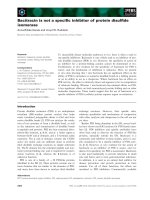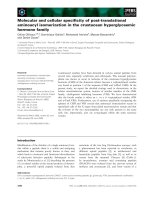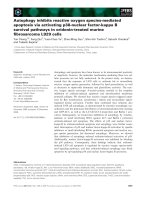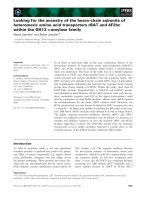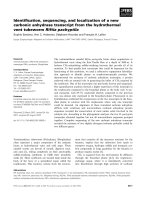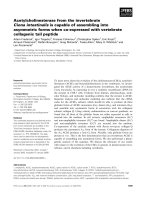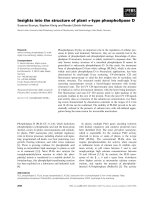Báo cáo khoa học: Bacitracin inhibits the reductive activity of protein disulfide isomerase by disulfide bond formation with free cysteines in the substrate-binding domain pptx
Bạn đang xem bản rút gọn của tài liệu. Xem và tải ngay bản đầy đủ của tài liệu tại đây (440.14 KB, 10 trang )
Bacitracin inhibits the reductive activity of protein
disulfide isomerase by disulfide bond formation with free
cysteines in the substrate-binding domain
Nina Dickerhof
1
, Torsten Kleffmann
2
, Ralph Jack
3
and Sally McCormick
1
1 Department of Biochemistry, University of Otago, Dunedin, New Zealand
2 Centre for Protein Research, University of Otago, Dunedin, New Zealand
3 Seperex Nutritionals, The Centre for Innovation, Dunedin, New Zealand
Introduction
Protein disulfide isomerase (PDI, EC 5.3.4.1)isan
endoplasmic reticulum-resident enzyme in eukaryotic
cells that catalyzes both the oxidation of cysteines to
form disulfide bonds and the reduction and rearrange-
ment of disulfide bonds in proteins, depending on the
redox potential of the cell [1–3]. PDI comprises four
structural thioredoxin-like domains, a, b, b¢ and a¢,
and an x-linker region between the b¢-domain and
a¢-domain [4–6]. The different activities of PDI are
carried out by different redox states of the catalytic
Cys-Gly-His-Cys motif present in each of the two
a-domains of PDI, which can exist in either the
reduced dithiol or the oxidized disulfide state [7].
The two b-domains are noncatalytic; however, the
b¢-domain displays a large hydrophobic surface, and
has been identified as the principal substrate-binding
domain of PDI [8,9].
The peptide antibiotic bacitracin was reported to be
an inhibitor of PDI in 1981 [10], and since then has
been widely used to demonstrate the role of PDI in
cellular processes, including glioma cell invasion [11],
melanoma cell death [12], virus entry [13,14], and
platelet function [15]. In vitro evidence for the specific-
ity of bacitracin as a PDI inhibitor, however, is
limited, and its mechanism of action remains elusive.
Karala and Ruddock [16] recently questioned the use
of bacitracin as a specific PDI inhibitor, after they
demonstrated a partial effect on the reductive activity
Keywords
bacitracin; cyclic peptide; protein disulfide
isomerase; protein disulfide isomerase (PDI)
inhibition; substrate-binding domain;
thiol–disulfide exchange
Correspondence
S. McCormick, Department of Biochemistry,
University of Otago, PO Box 56, Dunedin,
New Zealand
Fax: +64 3 479 7866
Tel: +64 3 479 7840
E-mail:
(Received 13 January 2011, revised 15
March 2011, accepted 6 April 2011)
doi:10.1111/j.1742-4658.2011.08119.x
The peptide antibiotic bacitracin is widely used as an inhibitor of protein
disulfide isomerase (PDI) to demonstrate the role of the protein-folding
catalyst in a variety of molecular pathways. Commercial bacitracin is a
mixture of at least 22 structurally related peptides. The inhibitory activity
of individual bacitracin analogs on PDI is unknown. For the present study,
we purified the major bacitracin analogs, A, B, H, and F, and tested their
ability to inhibit the reductive activity of PDI by use of an insulin aggrega-
tion assay. All analogs inhibited PDI, but the activity (IC
50
) ranged from
20 l
M for bacitracin F to 1050 lM for bacitracin B. The mechanism of PDI
inhibition by bacitracin is unknown. Here, we show, by MALDI-
TOF ⁄ TOF MS, a direct interaction of bacitracin with PDI, involving
disulfide bond formation between an open thiol form of the bacitracin
thiazoline ring and cysteines in the substrate-binding domain of PDI.
Abbreviations
ACN, acetonitrile; CID, collision-induced dissociation; PDI, protein disulfide isomerase.
2034 FEBS Journal 278 (2011) 2034–2043 ª 2011 The Authors Journal compilation ª 2011 FEBS
of PDI, but no effect of bacitracin on PDI-catalyzed
disulfide formation or isomerization.
Bacitracin, a dodecapeptide antibiotic produced by
certain strains of Bacillus licheniformis and Bacillus
subtilis, is a mixture of at least 22 structurally related
peptides, which can be separated by RP-HPLC and
characterized by MS [17]. The basic structure of bacitra-
cin consists of a cyclic peptide of seven amino acids with
a linear peptide side chain of five amino acids (Fig. 1A).
A thiazoline ring is present at the N-terminus of the pep-
tide formed either by l-cysteine and l-isoleucine or by
l-cysteine and l-valine. The various analogs result from
substitutions of hydrophobic amino acids within the
peptide sequence and from oxidative transformation of
the thiazoline ring. For example, bacitracin A, B1, B2
and B3 are transformed into bacitracin F, H1, H2 and
H3, respectively, by oxidation of the amino-thiazoline
ring to the keto-thiazole ring [18,19]. Bacitracin A
makes up approximately 70% of the total mass of com-
mercial bacitracin and, together with bacitracin B1, B2
and B3, accounts for more than 96% of total antimicro-
bial activity in commercial bacitracin products [20]. The
analog responsible for the reported inhibitory activity
on PDI is unknown. Here, we have purified bacitra-
cin A, B1–3, F and H1–3, and tested their ability to inhi-
bit the reductive activity of PDI. Furthermore, we have
investigated the mechanism of action of bacitracin on
PDI, and demonstrated its ability to form disulfide
bonds with cysteines in the substrate-binding domain of
PDI.
Results
The separation of commercial bacitracin into individ-
ual analogs was achieved by RP-HPLC (Fig. 1B).
Major peaks were collected, pooled and analyzed by
MALDI-TOF ⁄ TOF MS to identify isolated bacitracin
analogs (Fig. 1C and Fig. S1). Bacitracin H and F,
containing the keto-thiazole ring, eluted at a later
retention time than bacitracin A and B, owing to their
increased hydrophobicity. The homogeneity of the iso-
lated fractions was subsequently assessed by analytical
RP-HPLC (Fig. 1D). The bacitracin B fraction showed
traces of early-eluting compounds, which are likely to
be products formed by breakdown after purification.
The ability of each analog to inhibit the reductive
activity of PDI was tested in a turbidometric assay based
on the reduction of insulin by dithiothreitol in the pres-
ence of PDI. Upon reduction, insulin forms aggregates,
and the rate of aggregation was followed by turbidity
measurement at 562 nm (Fig. 2A–E). The kinetics of
this reaction were biphasic, with an initial lag phase fol-
lowed by an exponential increase in turbidity. In each
case, the presence of the bacitracin analog resulted in a
longer lag phase and an attenuated increase in turbidity,
in a dose-dependent manner. Figure 2F shows a compar-
ison of the absorbance reached at 100 min when each
analog was present at a concentration of 100 lm.
Bacitracin F and H were the most effective analogs.
Dose–response curves were generated to obtain IC
50
values for each analog by expressing activity as absor-
bance at 100 min as a percentage of the control absor-
bance obtained with no inhibitor present (Fig. 3).
Bacitracin F and H were found to be approximately
25-fold more active as PDI inhibitors than bacitracin A
and B (IC
50
of 20 and 40 lm versus 590 and 1050 lm,
respectively). The IC
50
of the commercial mix was 70 lm.
The mechanism of action of bacitracin on PDI is
unclear. In order to determine a direct interaction of
bacitracin with PDI, we separated incubations contain-
ing bacitracin analogs and PDI by SDS ⁄ PAGE.
Western blot analysis with an anti-PDI serum and an
antibody against bacitracin showed that each bacitra-
cin analog comigrated with PDI in SDS ⁄ PAGE under
nonreducing conditions (Fig. 4A). This suggests that
bacitracin undergoes a robust interaction with PDI
that is resistant to the denaturing conditions in
SDS ⁄ PAGE. However, the PDI–bacitracin complex
could not be detected under reducing conditions, indi-
cating that reducible bond formation is involved in the
PDI–bacitracin interaction. Furthermore, we showed
that the PDI–bacitracin complex could be immunopre-
cipitated with an anti-PDI serum (Fig. 4B), using pro-
tein G beads. Several washing steps of the beads with
NaCl ⁄ P
i
containing 0.1% Tween-20 did not diminish
the immunoblot signals for bacitracin at the site of
PDI (Fig. 4C). These data support the view of a robust
covalent PDI–bacitracin interaction.
We hypothesized that the thiazoline ring of bacitra-
cin reacts with cysteines on PDI to form disulfide
bonds. On the basis of reported disulfide formation
resulting from opening of a thiazole ring to a thiol
form [21], we proposed a mechanism of ring opening
for bacitracin with subsequent disulfide bond forma-
tion with free cysteines on PDI ( Fig. 5A). In order to
test this proposed mechanism, we performed in-gel
tryptic digestions of the PDI–bacitracin complex, and
analyzed the generated peptides by MALDI-TOF ⁄
TOF MS. Mass spectra were investigated for peaks
with a predicted [M + H]
+
potentially comprising cys-
teine-containing PDI peptides crosslinked to the open
thiol form of bacitracin. Figure 5B shows an example
for a predicted crosslink between the Cys345-contain-
ing PDI peptide Ile341–Arg347 ([M + H]
+
: 905.43)
and the open thiol form of bacitracin A ([M + H]
+
:
1440.77). A peak at m⁄ z 2343.09 was detected in the
N. Dickerhof et al. Bacitracin forms a disulfide bond with free PDI cysteines
FEBS Journal 278 (2011) 2034–2043 ª 2011 The Authors Journal compilation ª 2011 FEBS 2035
mass spectrum, which matched the predicted
[M + H]
+
of 2343.17 for this crosslinked peptide
(Fig. 5C). The precursor m ⁄ z 2343.09 was selected for
collision-induced dissociation (CID)-TOF ⁄ TOF MS
analysis. The MS ⁄ MS spectrum acquired in positive
ion mode showed a cluster of three peaks at
m ⁄ z 871.36, 905.36 and 937.33 (Fig. 5D), which are 34
and 32 mass units apart, respectively. This peak cluster
is indicative of the Ile341–Arg347 peptide being
involved in a disulfide bond. The three peaks represent
CID-based cleavage events at the cysteine b carbon–
sulfur bond, with double bond formation between the
Fig. 1. Separation of bacitracin analogs. (A) Structures of the most abundant bacitracin analogs of commercial bacitracin mixtures including
the amino-thiazoline ring (a) and (b) or keto-thiazole ring (c) and (d). (B) Representative chromatogram for the separation of bacitracin by RP-
HPLC, with a gradient of 10–90% ACN over 40 min and detection at 252 nm. Bacitracin A and F and bacitracin B and H were purified as
pooled fractions of B 1–3 and H 1–3. (C) MALDI-TOF ⁄ TOF MS spectrum of bacitracin F: The most significant fragment ions, their structures
and m ⁄ z values that were used to discriminate different bacitracin analogs by MALDI-TOF ⁄ TOF MS are shown. (D) The purity of each frac-
tion was assessed by analytical RP-HPLC, with similar conditions as used for the preparative RP-HPLC.
Bacitracin forms a disulfide bond with free PDI cysteines N. Dickerhof et al.
2036 FEBS Journal 278 (2011) 2034–2043 ª 2011 The Authors Journal compilation ª 2011 FEBS
a and b carbons (871.36), the sulfur–sulfur bond
(905.36) and the sulfur–carbon bond of the open thiaz-
oline ring of bacitracin A (937.33).
Negative ion mode CID-TOF ⁄ TOF MS analysis of
the same precursor yielded the corresponding signature
peaks (m ⁄ z 1404.88, 1438.82 and 1470.80) of the other
part of the disulfide bond, i.e. the negatively charged
open-ring bacitracin A ion without sulfur, free thiol
and two sulfurs, respectively (Fig. 5E).
All three sulfur bonds are prone to cleavage upon
ionization by increased laser energy, which generates a
small proportion of fragments in the ion source. The
combination of in-source decay of the precursor
m ⁄ z 2343.09 with CID on the in-source fragment
m ⁄ z 937.22 in positive ion mode confirmed the location
of the disulfide (Fig. 5F). The in-source decay ⁄ CID
fragment spectrum yielded unambiguous sequence
information for the Cys345-containing PDI peptide,
with an additional 32 mass units at position 345
(Fig. 5F).
In addition to Cys345, Cys314 was also found to be
crosslinked to bacitracin (Fig. S2).
Discussion
The peptide antibiotic bacitracin is widely used experi-
mentally in vivo as a specific PDI inhibitor, although
evidence for its specificity is scarce, and the activities
of its different analogs are unknown. Our study dis-
sected the activities of the various major bacitracin
analogs on the reductive activity of PDI, and showed
that the H and F analogs are 25-fold more active than
the A and B analogs.
As Karala and Ruddock [16] could not demonstrate
a significant effect of 1 mm commercial bacitracin on
the oxidase and isomerase activities of PDI, we con-
centrated on the reductive activity of PDI in this
study. When Roth [10] originally identified bacitracin
as an inhibitor of PDI, they studied the reduction of
insulin by rat liver lysates, and found that 250 lm
Fig. 2. Insulin reduction by PDI in the presence or absence of bacitracin analogs. (A–E) Insulin (1 mgÆmL
)1
) was incubated in 100 mM potas-
sium phosphate and 1 m
M EDTA (pH 7.4) in the absence (uncatalyzed) or presence of 10 lgÆmL
)1
PDI and increasing amounts of commer-
cial bacitracin or individual bacitracin analogs. The reaction was initiated with 0.1 m
M dithiothreitol (at time 0). (F) Comparison of A at
100 min after incubation with 100 l
M of each analog. Data are presented as mean ± standard error of independent triplicate experiments.
*P < 0.05 and ***P < 0.001 for comparison with the control.
N. Dickerhof et al. Bacitracin forms a disulfide bond with free PDI cysteines
FEBS Journal 278 (2011) 2034–2043 ª 2011 The Authors Journal compilation ª 2011 FEBS 2037
inhibited 90% of the activity. Smith et al. [22] reported
an IC
50
value of 152 lm for bacitracin for the inhibi-
tion of PDI reductive activity. The IC
50
value deter-
mined in our study for the inhibition of PDI reductive
activity by bacitracin was 70 lm. The experimental
conditions in all studies varied with respect to dith-
iothreitol, PDI and insulin concentrations, which may
in part account for differences in the IC
50
values for
bacitracin-mediated inhibition of PDI reductive activ-
ity. Furthermore, on the basis of our results, the inhib-
itory activity of the bacitracin mixture will depend on
the concentrations of individual bacitracin analogs.
Indeed, we found that bacitracin sourced from differ-
ent suppliers varies in analog composition.
The commercial bacitracin that we used here
consisted of 65% bacitracin A and B as analyzed by
analytical RP-HPLC. We therefore expected the IC
50
of the commercial bacitracin to be close to the IC
50
values for bacitracin A and B (590 and 1050 lm,
respectively). However, the IC
50
of commercial bacitra-
cin (70 lm) was much lower, and closer to the IC
50
of
the less abundant bacitracin H and F (40 and 20 lm,
respectively). We believe that, along with bacitracin H
and F, there are other more active but low-abundance
analogs within the commercial bacitracin mix that con-
tribute to the lower than expected IC
50
. This is evident
from the many minor peaks observed in the HPLC
separation of commercial bacitracin (Fig. 1B), and
supported by reports identifying up to 22 different bac-
itracin analogs [17]. We have purified and tested only
the four major analogs here, as purification of the low-
abundance analogs would yield insufficient quantities
for activity studies.
The mechanism of the inhibitory action of bacitracin
on PDI is unclear. Bacitracin acts as an antibiotic by
forming a complex between divalent cations and the
bacterial C
55
-isoprenyl lipid carrier, ultimately resulting
in the inhibition of cell wall biosynthesis. A free amino
group adjacent to a thiazoline ring has been shown to
be essential for bacitracin to form a complex with
divalent cations [23]. Bacitracin A and B fulfill this
requirement, making them the active antimicrobial
compounds of the bacitracin mix. The oxidation of the
amino-thiazoline ring to the keto-thiazole ring to form
bacitracin H and F results in a loss of metal binding
and subsequent antimicrobial activity [20]. However,
we show here that the ability to inhibit PDI is higher
for bacitracin H and F, which excludes the coordina-
tion of metal ions as a potential mechanism of action
on PDI.
Fig. 3. Dose–response curves of bacitracin analogs. PDI activity
was expressed as A
562 nm
at 100 min as a percentage of the
A
562 nm
of the control reaction containing no inhibitor after subtrac-
tion of the A
562 nm
of the uncatalyzed reaction. Data are presented
as mean ± standard error of independent triplicate experiments.
Nonlinear regression analysis revealed IC
50
values, which are given
along with the 95% confidence level range in parentheses.
Fig. 4. Bacitracin binding to PDI. (A) Incubations of 10 lgÆmL
)1
PDI
and 250 l
M bacitracin analog were subjected to separation by
SDS ⁄ PAGE, under either reducing or nonreducing conditions, and
western blot analysis. Blots were probed with both rabbit poly-
clonal anti-PDI serum and peroxidase-conjugated anti-rabbit IgG, or
with a peroxidase-conjugated sheep anti-bacitracin IgG. (B) Incuba-
tions of 10 lgÆmL
)1
PDI and 250 lM commercial bacitracin were
also subjected to immunoprecipitation with a polyclonal anti-PDI
serum, using protein G beads. Immunoprecipitates were eluted
from the beads after three washes with NaCl ⁄ P
i
containing 0.1%
Tween-20, separated by SDS ⁄ PAGE, and subjected to western blot
analysis under nonreducing conditions. (C) Immunoprecipitates
were eluted from the beads after three, four and five washes with
NaCl ⁄ P
i
containing 0.1% Tween-20.
Bacitracin forms a disulfide bond with free PDI cysteines N. Dickerhof et al.
2038 FEBS Journal 278 (2011) 2034–2043 ª 2011 The Authors Journal compilation ª 2011 FEBS
To further investigate the mechanism of inhibition
of PDI by bacitracin, we tested for a direct interaction
between PDI and bacitracin. We were able to demon-
strate a direct and covalent interaction of each bacitra-
cin analog with PDI by colocalization in immunoblot
analyses after SDS ⁄ PAGE, as well as by coimmuno-
Fig. 5. Disulfide bond formation between bacitracin and Cys345 on PDI. (A) Scheme of thiol formation of the thiazoline ring of bacitracin A
with subsequent formation of a mixed disulfide with PDI. (B) Proposed crosslink between the PDI peptide Ile341–Arg347 and bacitracin A
through a disulfide bond between Cys345 and the thiol form of bacitracin A. The thiol form of the thiazoline ring of bacitracin A and Cys345
are shown as chemical structures, the rest of bacitracin A as ‘Bacitracin A’, and all other amino acids not involved in the crosslink by the sin-
gle-letter code. The PDI peptide side of the disulfide bond is named R1, and the bacitracin side R2. (C) MALDI-TOF MS spectrum of pep-
tides generated by tryptic digestion of the PDI–bacitracin complex containing the crosslinked peptide Ile341–Arg347 ⁄ bacitracin A (arrow). (D)
Area of the CID-TOF ⁄ TOF MS spectrum of the precursor ion m ⁄ z 2343.09 acquired in positive ion mode, showing signature peaks for the
peptide [M + H]
+
905.36 involved in a disulfide bond. (E) Area of the CID-TOF ⁄ TOF MS spectrum of the precursor ion m ⁄ z 2341.09 acquired
in negative ion mode, showing signature peaks for the open thiol form of bacitracin A [M – H]
)
1438.82 involved in a disulfide bond. (F) In-
source decay of the precursor ion m ⁄ z 2343.09 combined with CID on the in-source fragment m ⁄ z 937.33 reveals an additional 32 mass
units at Cys345 (arrow), confirming the disulfide bond at this position.
N. Dickerhof et al. Bacitracin forms a disulfide bond with free PDI cysteines
FEBS Journal 278 (2011) 2034–2043 ª 2011 The Authors Journal compilation ª 2011 FEBS 2039
precipitation of bacitracin and PDI with an anti-PDI
serum. We showed that the interaction was disrupted
under reducing conditions, indicating the involvement
of disulfide bond formation. We hypothesized that
bacitracin may react with cysteines on PDI to form a
disulfide bond. Using MALDI-TOF ⁄ TOF MS analy-
sis, we were able to show that disulfide bond forma-
tion occurs between an open thiol form of bacitracin
and Cys314 and Cys345 of PDI.
PDI comprises four domains, a, b, b¢ and a¢, and an
x-linker region between the b¢-domain and a¢-domain.
The a-domains are catalytically active, the b¢-domain
functions as a substrate-binding domain displaying a
large hydrophobic surface area, and the x-linker func-
tions to gate access to the b¢-domain [8,9,24]. The
cysteines involved in disulfide bond formation
with bacitracin, Cys314 and Cys345, are present in the
b¢-domain and x-linker, respectively. The crystal struc-
ture of this region of PDI shows that these cysteines
are free [9]. We propose that bacitracin binds to the
hydrophobic surface of the substrate-binding region of
PDI, allowing subsequent disulfide bond formation
with the free cysteines Cys314 and Cys345. The pres-
ence of the covalently bound bacitracin in this region
would impair the binding of the substrate insulin, ulti-
mately inhibiting its reduction. Although all bacitracin
analogs seem to interact covalently with PDI (Fig. 4),
there is a 25-fold increase in inhibitory activity
between bacitracin A and B and bacitracin F and H,
respectively. If we assume that bacitracin interacts with
the hydrophobic surface of the substrate-binding site
prior to the disulfide bond formation with Cys314 or
Cys345, bacitracin H and F, which are more hydro-
phobic than bacitracin A and B, might be more potent
binding partners.
Karala and Ruddock [16] tested the effect of bacitra-
cin on the reductive activity of a truncated PDI con-
taining the catalytic a-domain, but lacking the
independent substrate-binding b¢-domain. Bacitracin
did not seem to affect the rate of catalysis of the trun-
cated PDI, whereas full-length PDI showed a signifi-
cantly lower rate of catalysis in the presence of
bacitracin. These findings can be explained by our
results showing that bacitracin targets the substrate-
binding domain of PDI, but not the catalytic domain.
Furthermore, Karala and Ruddock [16] showed no
effect of bacitracin on the oxidase activity of PDI,
which can be carried out by either of the catalytic
domains, a or a¢, with no requirement for the sub-
strate-binding domain [25].
Although bacitracin has been commonly used as a
specific PDI inhibitor, its ability to react with cysteines
is unlikely to be limited to PDI. Indeed, we have tested
the binding of bacitracin to various proteins, and
found it to bind BSA and IgG (Fig. S3). Interestingly,
it did not bind apolipoprotein A1 or pepsin (Fig. S3),
neither of which has any free cysteines. We assume
that the same mechanism of bacitracin binding as
shown here for PDI applies to other proteins contain-
ing free cysteines.
In conclusion, we show a mechanism of action of
bacitracin on PDI that involves covalent binding of an
open thiol form of bacitracin to free cysteines in the
substrate-binding domain of PDI. However, the inter-
action between bacitracin and PDI is nonspecific, and
applies to other proteins containing free cysteines.
Experimental procedures
Materials
As commercial bacitracin has been reported to contain pro-
teases [26], we incubated 5 mm bacitracin from different
sources with 1 mg of BSA, and tested for albumin degrada-
tion by SDS ⁄ PAGE. No evidence of degradation was
found with bacitracin sourced from Calbiochem (Gibbs-
town, NJ, USA), and this was used for subsequent experi-
ments. PDI from bovine liver was purchased from Sigma
(St Louis, MO, USA), porcine monocomponent insulin
from Nova Research (Copenhagen, Denmark), dithiothrei-
tol from Roche (Mannheim, Germany), peroxidase-conju-
gated goat anti-rabbit IgG from Thermo Fisher Scientific
(Rockford, IL, USA), and Pure Proteome Protein G Mag-
netic Beads from Millipore (Billerica, MA, USA). The anti-
bacitracin IgG was purchased from GenWay Biotech (San
Diego, CA, USA), and conjugated with peroxidase by use
of a Lightning Link labelling kit (Innova Biosciences, Cam-
bridge, UK). Polyclonal rabbit anti-rat PDI serum, which
crossreacts with bovine PDI [27], was a generous gift from
M. Hubbard (University of Melbourne).
Purification of bacitracin analogs and
MALDI-TOF
⁄
TOF MS analysis
The nomenclature of Ikai et al. [20] for the different baci-
tracin analogs was used in this study. Bacitracin A, B1–3,
H1–3 and F (referred to as bacitracin A, B, H and F,
respectively) were isolated by semipreparative RP-HPLC on
C-18 resin, using a Jasco (Great Dunmow, UK) HPLC sys-
tem with an LG 2080-02 Ternary Gradient pump, a
DG 2080 Degasser, and an MD 2010-plus detector. Baci-
tracin was dissolved at a concentration of 50 mg ÆmL
)1
in
10% acetonitrile (ACN) containing 0.1% trifluoroacetic
acid, and filtered through a 0.2 lm filter; 10 mg was then
injected for separation on a preparative XTerra MS C-18
column (5 lm, 10 · 150 mm; Waters, Milford, MA, USA).
A gradient was run from 10% to 90% ACN containing
Bacitracin forms a disulfide bond with free PDI cysteines N. Dickerhof et al.
2040 FEBS Journal 278 (2011) 2034–2043 ª 2011 The Authors Journal compilation ª 2011 FEBS
0.1% trifluoroacetic acid over 40 min at a flow rate of
7mLÆmin
)1
to elute the various analogs, which were moni-
tored by absorbance at 252 nm. Fractions were subse-
quently analyzed for purity by analytical RP-HPLC, with
the same gradient, at a flow rate of 0.6 mLÆmin
)1
,onan
analytical XTerra MS C-18 column (3.5 lm, 3 · 10 mm).
The structural identity of the isolated analogs was con-
firmed by MALDI-TOF ⁄ TOF MS, with a 4800 MALDI-
TOF ⁄ TOF Analyzer (AB SCIEX, Framingham, MA,
USA). MALDI-TOF and TOF ⁄ TOF MS spectra were
acquired with 800–1000 and 2000–2800 laser shots per sam-
ple spot, respectively. For based MS ⁄ MS, the 2-kV opera-
tion mode was used, with air as collision gas at a pressure
of 1 · 10
6
Torr.
Purified fractions were dried by rotary evaporation under
vacuum, dissolved in 80% 2-methyl-propan-2-ol containing
0.05% HCl, and subsequently lyophilized. The weight of
the dry bacitracin analog was determined, and it was
dissolved in NaCl ⁄ P
i
for activity assays.
Testing the effect of bacitracin analogs on PDI
reductive activity
PDI activity was measured with an assay that measures the
catalytic reduction of insulin, as described by Holmgren
[28]. Insulin (1 mgÆmL
)1
) was incubated in 100 mm potas-
sium phosphate and 1 mm EDTA (pH 7.4), in the presence
of 10 lgÆmL
)1
PDI and varying amounts of bacitracin ana-
log at room temperature. The reaction was initiated after
10 min by the addition of 0.1 mm dithiothreitol, and the
increase in turbidity was monitored at 562 nm on an
Elx808 Ultra Microplate Reader (Bio-Tex Instruments,
Winooski, VT, USA) over 100 min. Dose–response curves
were generated, with expression of PDI activity as absor-
bance at 100 min as a percentage of the absorbance of the
control reaction containing no inhibitor, after subtraction
of the absorbance of the uncatalyzed reaction containing
no PDI. IC
50
values were determined by applying a
nonlinear least squares fit of the equation Y = bot-
tom + (top – bottom) ⁄ {1 + 10^[(log IC
50
– X)*Hill slope]}
to activity versus the log of inhibitor concentration, using
graph pad prism Version 5.0 for MacOSX (San Diego,
CA, USA). Although the Hill slope was variable, the
bottom and top values were constrained to 0 and 100,
respectively.
Analysis of PDI–bacitracin interaction by
SDS
⁄
PAGE and immunoprecipitation
PDI at 10 lgÆmL
)1
was incubated with 250 lm bacitracin
analog in a total volume of 100 lL for 30 min at room
temperature. The reaction mixtures were separated by 10%
SDS ⁄ PAGE under either reducing or nonreducing condi-
tions, and subsequently transferred to nitrocellulose
membrane. Blots were probed with both rabbit polyclonal
anti-PDI serum and peroxidase-conjugated anti-rabbit IgG
or with peroxidase-conjugated sheep antibody against
bacitracin.
For immunoprecipitation studies, 5 lL of polyclonal
anti-PDI serum was added to the PDI–bacitracin reactions
and incubated overnight at 4 °C. The reaction mixture was
then added to 50 lL of magnetic protein G beads and incu-
bated for 90 min at room temperature. The beads were
washed three times with NaCl ⁄ P
i
containing 0.1% Tween-
20, before elution of the complex from the beads by addi-
tion of SDS buffer and heating at 90 °C for 10 min. To
demonstrate a robust interaction between bacitracin and
PDI, the beads were also washed four and five times with
NaCl ⁄ P
i
containing 0.1% Tween-20 before elution. The
imunoprecipitates were separated by 10% SDS ⁄ PAGE
under nonreducing conditions, and subjected to western
blot analysis as described above.
Analysis of PDI–bacitracin interaction by
MALDI-TOF
⁄
TOF MS
PDI was incubated with commercial bacitracin, and reac-
tion mixtures were separated by 10% SDS ⁄ PAGE under
nonreducing conditions, as described above. After staining
with Coomassie Blue, the protein band was excised from
the SDS polyacrylamide gel and subjected to in-gel diges-
tion with trypsin to generate crosslinked peptides. Proteins
were digested with trypsin at a ratio of 1 lg of protease to
10 lg of protein at 37 °C for 15 h. Tryptic fragments were
eluted from the gel matrix and analyzed by MALDI-TOF ⁄
TOF MS.
The PDI–bacitracin was characterized by a combination
of in-source decay and CID-TOF ⁄ TOF MS, based on the
method described by Kleffmann et al. [29]. Briefly, for a
selected precursor analysis, spectra were investigated for
peaks with a predicted [M + H]
+
potentially containing
PDI peptides with a cysteine crosslinked to bacitracin.
Diagnostic crosslinked peptide ions were subjected to
MALDI-TOF ⁄ TOF MS analysis. Spectra were acquired in
the 2-kV positive and 1-kV negative ion mode, with 2000–
2800 laser shots per sample spot. For unambiguous deter-
mination of the amino acids involved in the crosslink for-
mation, peptide ions generated by in-source decay of the
crosslinked peptide were selected for further fragmentation
by CID.
Acknowledgements
We are very grateful to S. Huettenhain for the use of
his HPLC equipment and for sending bovine PDI. We
thank S. Wilbanks and G. Jameson for helping us to
interpret data and providing insights into potential
inhibitory mechanisms. We would also like to thank
N. Dickerhof et al. Bacitracin forms a disulfide bond with free PDI cysteines
FEBS Journal 278 (2011) 2034–2043 ª 2011 The Authors Journal compilation ª 2011 FEBS 2041
A. von Zychlinksy-Kleffmann and D. Petras for their
kind assistance regarding the purification, as well as
M. Hubbard for the polyclonal antibody against PDI.
This work was supported in part by the National
Heart Foundation, New Zealand (Grant No. 1321).
References
1 Bassuk JA & Berg RA (1989) Protein disulphide isom-
erase, a multifunctional endoplasmic reticulum protein.
Matrix 9, 244–258.
2 Freedman RB (1989) Protein disulfide isomerase: multi-
ple roles in the modification of nascent secretory
proteins. Cell 57, 1069–1072.
3 Noiva R & Lennarz WJ (1992) Protein disulfide isomer-
ase. A multifunctional protein resident in the lumen of
the endoplasmic reticulum. J Biol Chem 267, 3553–
3556.
4 Freedman RB, Gane PJ, Hawkins HC, Hlodan R,
McLaughlin SH & Parry JW (1998) Experimental and
theoretical analyses of the domain architecture of mam-
malian protein disulphide-isomerase. Biol Chem 379,
321–328.
5 Klappa P, Ruddock LW, Darby NJ & Freedman RB
(1998) The b¢ domain provides the principal peptide-
binding site of protein disulfide isomerase but all
domains contribute to binding of misfolded proteins.
EMBO J 17, 927–935.
6 Pirneskoski A, Klappa P, Lobell M, Williamson RA,
Byrne L, Alanen HI, Salo KE, Kivirikko KI, Freedman
RB & Ruddock LW (2004) Molecular characterization
of the principal substrate binding site of the ubiquitous
folding catalyst protein disulfide isomerase. J Biol Chem
279, 10374–10381.
7 Schwaller M, Wilkinson B & Gilbert HF (2003) Reduc-
tion–reoxidation cycles contribute to catalysis of disul-
fide isomerization by protein-disulfide isomerase. J Biol
Chem 278, 7154–7159.
8 Byrne LJ, Sidhu A, Wallis AK, Ruddock LW, Freed-
man RB, Howard MJ & Williamson RA (2009)
Mapping of the ligand-binding site on the b¢ domain of
human PDI: interaction with peptide ligands and the
x-linker region. Biochem J 423, 209–217.
9 Denisov AY, Maattanen P, Dabrowski C, Kozlov G,
Thomas DY & Gehring K (2009) Solution structure of
the bb¢ domains of human protein disulfide isomerase.
FEBS J 276, 1440–1449.
10 Roth RA (1981) Bacitracin: an inhibitor of the insulin
degrading activity of glutathione-insulin transhydrogen-
ase. Biochem Biophys Res Commun 98, 431–438.
11 Goplen D, Wang J, Enger PO, Tysnes BB, Terzis AJ,
Laerum OD & Bjerkvig R (2006) Protein disulfide isom-
erase expression is related to the invasive properties of
malignant glioma. Cancer Res 66, 9895–9902.
12 Lovat PE, Corazzari M, Armstrong JL, Martin S,
Pagliarini V, Hill D, Brown AM, Piacentini M,
Birch-Machin MA & Redfern CP (2008) Increasing
melanoma cell death using inhibitors of protein
disulfide isomerases to abrogate survival responses to
endoplasmic reticulum stress. Cancer Res 68, 5363–
5369.
13 Markovic I, Stantchev TS, Fields KH, Tiffany LJ,
Tomic M, Weiss CD, Broder CC, Strebel K & Clouse
KA (2004) Thiol ⁄ disulfide exchange is a prerequisite for
CXCR4-tropic HIV-1 envelope-mediated T-cell fusion
during viral entry. Blood 103, 1586–1594.
14 Ryser HJ, Levy EM, Mandel R & DiSciullo GJ (1994)
Inhibition of human immunodeficiency virus infection
by agents that interfere with thiol–disulfide interchange
upon virus–receptor interaction. Proc Natl Acad Sci
USA 91, 4559–4563.
15 Essex DW, Li M, Miller A & Feinman RD (2001) Pro-
tein disulfide isomerase and sulfhydryl-dependent path-
ways in platelet activation. Biochemistry 40, 6070–6075.
16 Karala AR & Ruddock LW (2010) Bacitracin is not a
specific inhibitor of protein disulfide isomerase. FEBS
J 277, 2454–2462.
17 Govaerts C, Li C, Orwa J, Van Schepdael A, Adams E,
Roets E & Hoogmartens J (2003) Sequencing of baci-
tracin A and related minor components by liquid chro-
matography ⁄ electrospray ionization ion trap tandem
mass spectrometry. Rapid Commun Mass Spectrom 17,
1366–1379.
18 Konigsberg W & Craig LC (1962) On bacitracin F.
J Organic Chem 27, 934–938.
19 Pavli V & Kmetec V (2001) Optimization of HPLC
method for stability testing of bacitracin. J Pharm
Biomed Anal 24, 977–982.
20 Ikai Y, Oka H, Hayakawa J, Matsumoto M, Saito M,
Harada K, Mayumi T & Suzuki M (1995) Total struc-
tures and antimicrobial activity of bacitracin minor
components. J Antibiot 48, 233–242.
21 Stepuro AI, Piletskaya TP & Stepuro II (2005) Role of
thiamine thiol form in nitric oxide metabolism.
Biochemistry (Mosc) 70, 339–349.
22 Smith AM, Chan J, Oksenberg D, Urfer R, Wexler DS,
Ow A, Gao L, McAlorum A & Huang SG (2004) A
high-throughput turbidometric assay for screening
inhibitors of protein disulfide isomerase activity.
J Biomol Screen 9, 614–620.
23 Ming L-J & Epperson JD (2002) Metal binding and
structure–activity relationship of the metalloantibiotic
peptide bacitracin. J Inorganic Biochem 91, 46–58.
24 Wang C, Chen S, Wang X, Wang L, Wallis AK, Freed-
man RB & Wang CC (2010) Plasticity of human pro-
tein disulfide isomerase: evidence for mobility around
the X-linker region and its functional significance.
J Biol Chem 285, 26788–26797.
Bacitracin forms a disulfide bond with free PDI cysteines N. Dickerhof et al.
2042 FEBS Journal 278 (2011) 2034–2043 ª 2011 The Authors Journal compilation ª 2011 FEBS
25 Freedman RB, Klappa P & Ruddock LW (2002) Pro-
tein disulfide isomerases exploit synergy between cata-
lytic and specific binding domains. EMBO Rep 3,
136–140.
26 Rogelj S, Reiter KJ, Kesner L, Li M & Essex D (2000)
Enzyme destruction by a protease contaminant in baci-
tracin. Biochem Biophys Res Commun 273, 829–832.
27 Shnyder SD & Hubbard MJ (2002) ERp29 is a ubiqui-
tous resident of the endoplasmic reticulum with a dis-
tinct role in secretory protein production. J Histochem
Cytochem 50, 557–566.
28 Holmgren A (1979) Thioredoxin catalyzes the reduction
of insulin disulfides by dithiothreitol and dihydrolipoa-
mide. J Biol Chem 254, 9627–9632.
29 Kleffmann T, Jongkees SA, Fairweather G, Wilbanks
SM & Jameson GN (2009) Mass-spectrometric charac-
terization of two posttranslational modifications of cys-
teine dioxygenase. J Biol Inorg Chem 14 , 913–921.
Supporting information
The following supplementary material is available:
Fig. S1. Assignment of MALDI-TOF ⁄ TOF MS signa-
ture peaks for bacitracin analogs.
Fig. S2. Disulfide bond formation between bacitracin
and Cys314 on PDI.
Fig. S3. Bacitracin binding to different proteins.
This supplementary material can be found in the
online version of this article.
Please note: As a service to our authors and readers,
this journal provides supporting information supplied
by the authors. Such materials are peer-reviewed and
may be re-organized for online delivery, but are not
copy-edited or typeset. Technical support issues arising
from supporting information (other than missing files)
should be addressed to the authors.
N. Dickerhof et al. Bacitracin forms a disulfide bond with free PDI cysteines
FEBS Journal 278 (2011) 2034–2043 ª 2011 The Authors Journal compilation ª 2011 FEBS 2043
